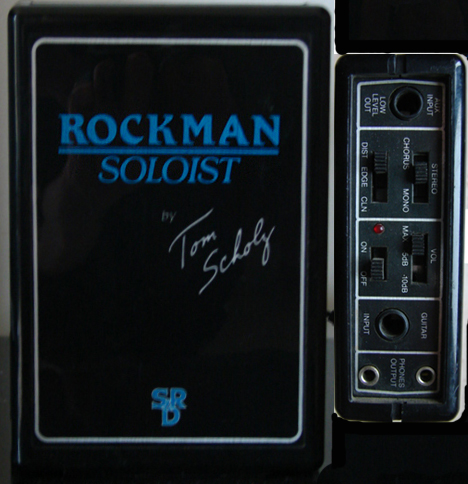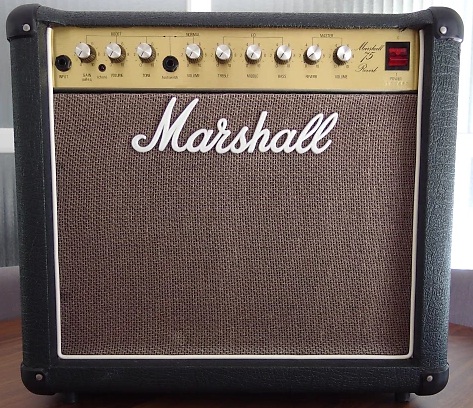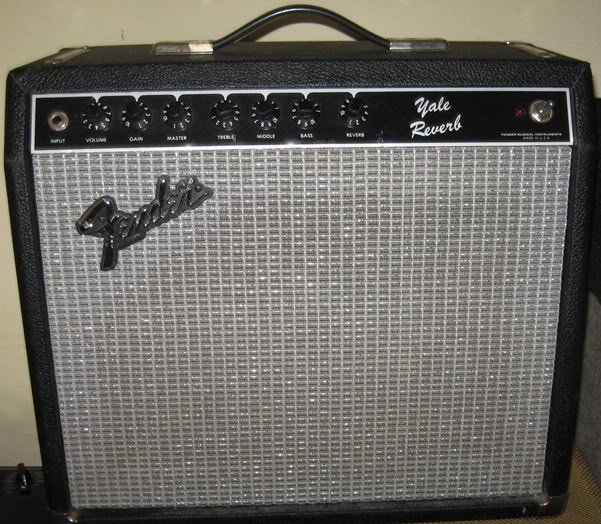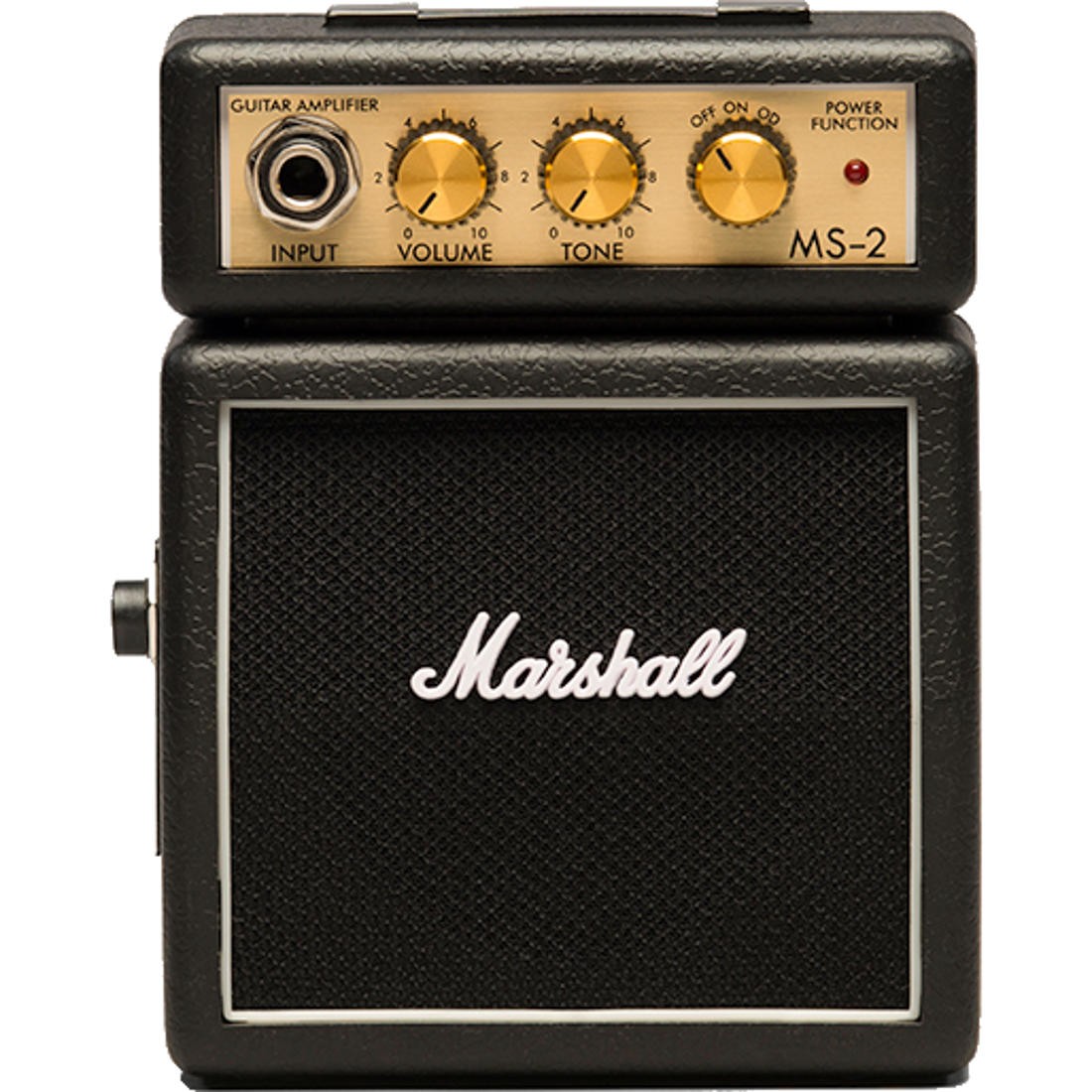MARSHALL MS-2
1 Watt of gut-wrenching power featuring: channel switching, a battery and a headphone jack that doubles as a preamp out, so you can rock while you roll.
This MS-2 black, mini half stack has bags of serious tone and is anything but a toy. It has even been used in professional recording studios; placed in a shoe box with a hole cut for a microphone. We kid you not.
LINE6 Spider IV 15

Spider(r) IV 15 delivers a perfectly distilled collection of celebrated American and British amp tones. With one-touch ease, access the 4 absolutely essential amp models that every guitarist needs.
Inspired by the features that made Spider III 15 the best-selling guitar amp in the U.S.*, Spider IV 15 boasts celebrated amp tones, 6 inspiring effects that add exceptional colors and textures, a built-in tuner, a three-band EQ section for tone-shaping control and more.
A wolf in sheep's clothing, Spider IV 15 sounds ferocious at low volumes as well as cranked to 11. Plus, value-packed, it puts pro sounds and into a lightweight box that's small enough to tuck under your bed or desk.
Amp Models
From sparkling clean tones to high-gain metal tones and beyond, Spider IV 15 delivers a perfectly distilled collection of history's most celebrated guitar tones.
The wide range of tones starts strong with a bright and distinctive American clean tone and then opens gradually to achieve the vintage grit and chime of classic British amplifiers. Experience the infamous "Brown" sound distortion, which is based on* a '68 Marshall(r) Plexi 100 with a Variac and jumped input channels, and a searing high-gain tone based on* a Mesa/Boogie(r) Dual Rectifier(r).
Each of the four Spider IV 15 amp models provides an exceptional guitar playing experience that you won't soon forget.
Channel A
Channel A delivers crisp clean tones, warm jazz tones and all the high-end shimmer you'll need with a generous amount of bottom end.
Channel B
Channel B conjures the infamous "Brown sound" inspired by* a '68 Marshall Plexi 100-watt with a Variac and jumped input channels.
Channel C
A one-way ticket to tight and punchy high-gain heaven, Channel C is inspired by* the high-gain tone of a Mesa/Boogie Dual Rectifier.
Channel D
Dialed in for shredding, Channel D combines the intensity and impact of Metal Red but it delivers more mid-range teeth for that bone-crushing grind. Inspired by* the tone of a Mesa/Boogie Dual Rectifier (red channel).
Smart FX
Color your tone with the unprecedented control of Line 6 Smart FX. Start smart with 6 exceptional Echoes, tangy Mods, a syrupy-sweet Reverb, and more. Simply find the effect you want, turn the knob to the desired intensity and you're done. Plus, Tap Tempo syncs all your time-based effects. Explore the sonic palette with up to two effects at once!
6 Smart FX (up to 2 at once)
- Chorus/Flanger
- Phaser
- Tremolo
- Sweep Echo
- Tape Echo
- Reverb
ROCKMAN Soloist

The Rockman was launched in 1982: it was an instant hit. In 1982, there was no homestudios, no DAW's, and playing DI through the band mixer was too exotic for a majority of guitarists. So the Rockman was completed by a fancy accessory: headphones! The name itself, Rockman, was based on Sony's Walkman ®, and a set of headphones was actually the most convenient way to provide quality stereo sound.
Stereo was a fantastic and really new feature. Today, in 2008, we have forgotten what mono was: only old chaps like me remember the mono record players and tape recorders we used in the seventies! The younger generations don't even know that there was mono AM radio before the stereo FM they are used to...
Ahead of its time? No. The Rockman was right on time, and arrived exactly when the market needed such a tool. That's the key factor of all the success stories...
Inside the Rockman
If you want to understand what a Rockman is and why it sounds so good, the first thing to do is to ...forget the headphones!
Think of the Rockman as a stereo amp simulator, designed to be connected directly into the soundcard of your PC, or in the mixer of your band. Once that said, let's take a look at the internal structure of a Rockman.
One can roughly identify two parts: a first mono section, that corresponds to the amp simulator in itself. Then a stereo effects section, with a stereo chorus and a stereo reverb.
All in all, you connect your guitar to the Rockman. The signal goes through:
A compressor
A distortion unit (or nothing in clean modes)
A cab sim
That's the amp simulator. Then the stereo part, where the Rockman creates two different versions of the signal:
One channel is based on the dry, original sound, plus some reverb
The other channel goes through a short delay modulated by an LFO (thats the chorus effect) plus another reverbed sound
MARSHALL 75 Reverb

Amplificatore a transistor 75 watt con distorsore / riverbero.
Entrambi gli effetti sono controllabili con pedale.
Speaker Celestion.
FENDER Yale Reverb

Fender Yale Reverb it has PLENTY of bass for jazz guitar. The 12-inch speaker and active 3-band EQ lets you boost the bass and duck the mids for a fat, mellow jazz sound. Brighten it up add the reverb and you have a sweet, breezy, 'California' jazz sound. It even has a pre-amp to power-amp effects loop if you get that picky. Gain control makes it either super clean or a little dirty. It's a pretty rare amp, only built from 1982-1986
